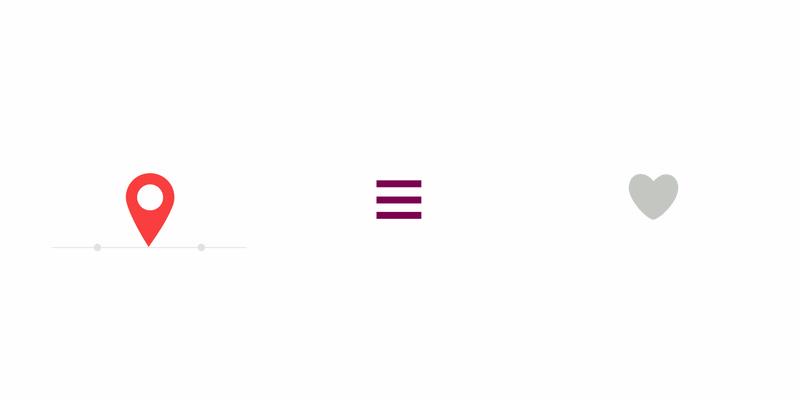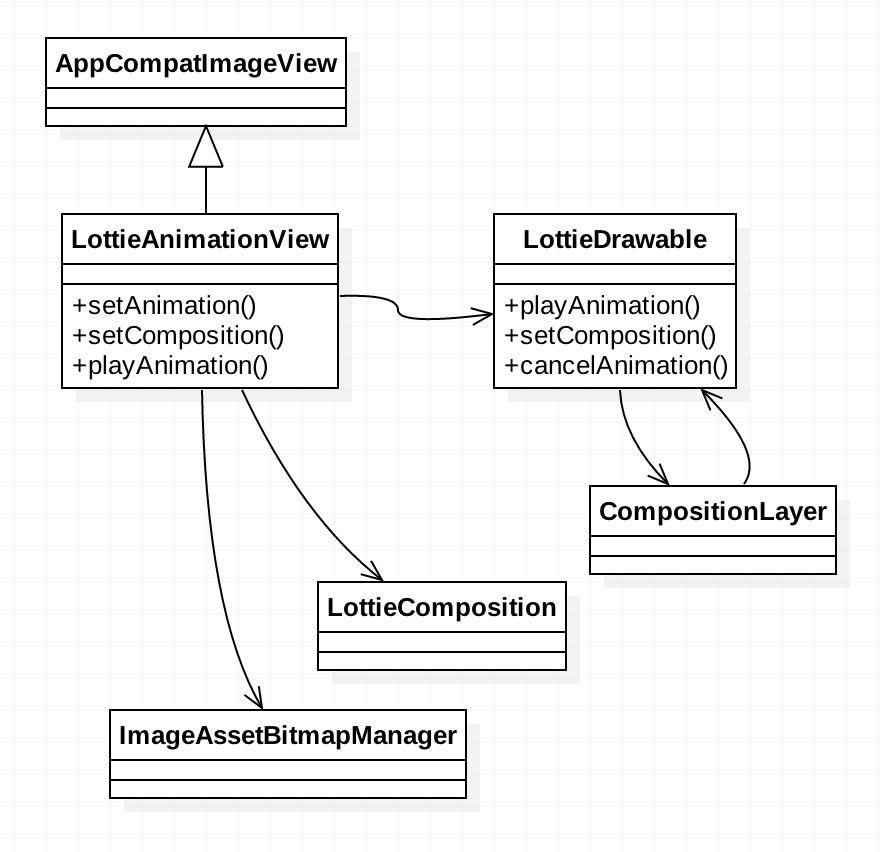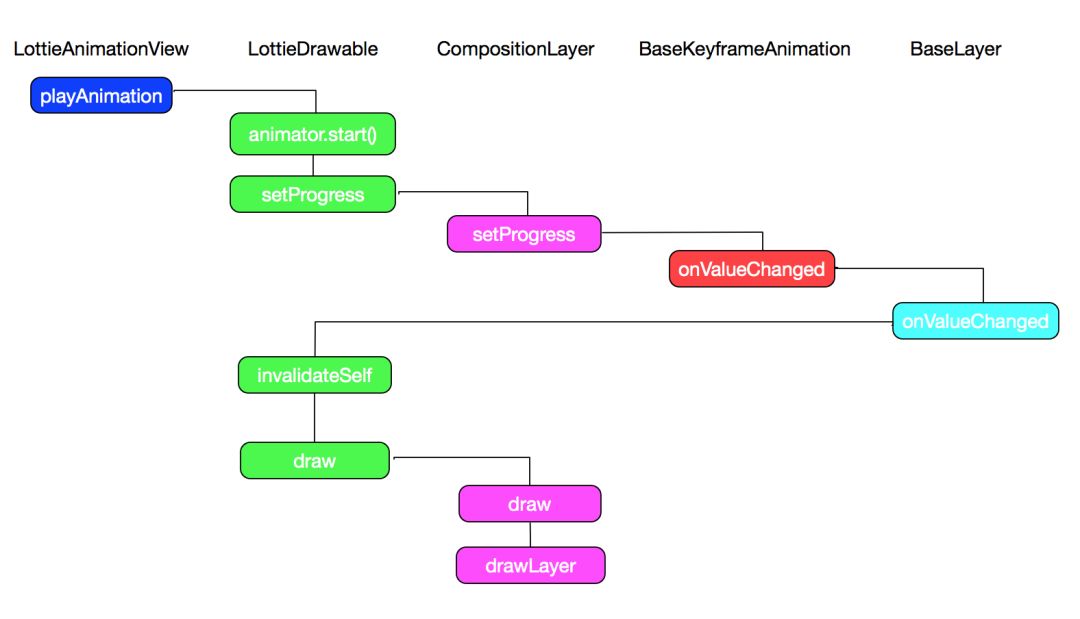源码分析丨Lottie 实现炫酷动画背后的原理
Posted 51CTO官微
tags:
篇首语:本文由小常识网(cha138.com)小编为大家整理,主要介绍了源码分析丨Lottie 实现炫酷动画背后的原理相关的知识,希望对你有一定的参考价值。
作者 l 程序亦非猿
来源 l 程序亦非猿(ID:chengxuyifeiyuan)
0. 前言
自我在内网发布了一篇关于 Lottie 的重点原理分析的文章之后,就不断有同事来找我询问关于 Lottie 的各种东西,最近又有同事来问,就想着可能对大家也会有所帮助,就稍作处理后分享出来。
注意一下哈,这文章写于两年前,基本版本 2.0.0-beta3,现在已经不止2.0.0啦,不过我看过最新版本,主要的类没有什么差别,依然有阅读价值。
可以感受一下我两年前的实力。:-D
走起!
1. Lottie 是什么?
Lottie 是 airbnb 发布的库,它可以将 AE 制作的动画 在 Android&iOS上以 native 代码渲染出来,目前还支持了 RN 平台。
来看几个官方给出的动画效果案例:
 有没有很炫酷?
有没有很炫酷?
就拿第一个动画 Jump-through 举例,如果让你来实现它,你能在多少时间内完成?三天?一个礼拜?google 的 Nick Butcher 刚好有一篇文章写 Jump-through 的动画实现,讲述了整个实现过程,从文章里可以看出实现这个动画并不容易,有兴趣的可以看看 Animation: Jump-through。
但是现在有了 Lottie,只要设计师用 AE 设计动画,利用 bodymovin 导出 ,导入到 assets, 再写下面那么点代码就可以实现了!
LottieAnimationView animationView = (LottieAnimationView) findViewById(R.id.animation_view);
animationView.setAnimation("PinJump.json");
animationView.loop(true);
animationView.playAnimation();
不用写自定义 View!不用画 Path!不用去计算这个点那个点!
是不是超级方便?!!!
这么方便的背后,原理是什么呢?
2. TL;DR
bodymovin 将 AE 动画导出为 ,该 描述了该动画,而 lottie-android 的原理就是将 描述的动画用 native code 翻译出来, 其核心原理是 canvas 绘制。对,lottie 的动画是靠纯 canvas 画出来的!!!动起来则是靠的属性动画。(ValueAnimator.ofFloat(0f, 1f); )
说具体点就是 lottie 随属性动画修改 progress,每一个 Layer 根据当前的 progress 绘制所对应的帧内容,progress 值变为1,动画结束。(有点类似于帧动画)
当然说说简单,lottie其实做了非常多的工作,后续将详细解析 lottie-android 的实现原理。
3. Lottie 关键类介绍
Lottie 提供了一个 LottieAnimationView 给用户使用,而实际 Lottie 的核心是 LottieDrawable,它承载了所有的绘制工作,LottieAnimationView则是对LottieDrawable 的封装,再附加了一些例如 解析 的功能。
LottieComposition 是 对应的 Model,承载 的所有信息。
CompositionLayer 是 layer 的集合。
ImageAssetBitmapManager 负责管理动画所需的图片资源。
它们的关系:

4. 文件的属性含义
bodymovin 导出的 包含了动画的一切信息, 动画的关键帧信息,动画该怎么做,做什么都包含在 里,Lottie 里所有的 Model 的数据都来自于这个 ( 该 对应的 Model 是LottieComposition),所以要理解 Lottie 的原理,理解 的属性是第一步。
属性非常多,而且不同的动画的 也有很大的差别,所以这里只讲解部分重要的属性。
4.1 文件最外部的结构
的最外层长这样:
{
"v": "4.5.9",
"fr": 15,
"ip": 0,
"op": 75,
"w": 500,
"h": 500,
"ddd": 0,
"assets":[]
"layers":[]
}
属性的含义:
| 属性 | 含义 |
|---|---|
| v | bodymovin的版本 |
| fr | 帧率 |
| ip | 起始关键帧 |
| op | 结束关键帧 |
| w | 动画宽度 |
| h | 动画高度 |
| assets | 动画图片资源信息 |
| layers | 动画图层信息 |
从这里可以获取 设计的动画的宽高,帧相关的信息,动画所需要的图片资源的信息以及图层信息。
a) assets
图片资源信息, 相关类 LottieImageAsset、 ImageAssetBitmapManager。
"assets": [
{
"id": "image_0",
"w": 500,
"h": 500,
"u": "images/",
"p": "voice_thinking_image_0.png"
}
]
属性的含义:
| 属性 | 含义 |
|---|---|
| id | 图片 id |
| w | 图片宽度 |
| h | 图片高度 |
| p | 图片名称 |
b) layers
图层信息,相关类:Layer、BaseLayer以及 BaseLayer 的实现类。
{
"ddd": 0,
"ind": 0,
"ty": 2,
"nm": "btnSlice.png",
"cl": "png",
"refId": "image_0",
"ks": {....},
"ao": 0,
"ip": 0,
"op": 90.0000036657751,
"st": 0,
"bm": 0,
"sr": 1
}
属性的含义:
| 属性 | 含义 |
|---|---|
| nm | layerName 图层信息 |
| refId | 引用的资源 id,如果是 ImageLayer 那么就是图片的id |
| ty | layertype 图层类型 |
| ip | inFrame 该图层起始关键帧 |
| op | outFrame 该图层结束关键帧 |
| st | startFrame 开始 |
| ind | layer id 图层 id |
Layer 可以理解为图层,跟 PS 等工具的概念相同,每个 Layer 负责绘制自己的内容。
在 Lottie 里拥有不同的 Layer,目前有 PreComp,Solid,Image,Null,Shape,Text ,各个 Layer 拥有的属性各不相同,这里只指出共有的属性。
下图为 Layer 相关类图:

5. Lottie 的适配原理
在开始使用 Lottie 的时候,我们团队设计动画走的跟设计图片一样的路子,想设计2x,3x 多份资源进行适配。但是,通过阅读源码发现其实 Lottie本身在 Android 平台已经做了适配工作,而且适配原理很简单,解析 时,从 读取宽高之后 会再乘以手机的密度。再在使用的时候判断适配后的宽高是否超过屏幕的宽高,如果超过则再进行缩放。以此保障 Lottie 在 Android 平台的显示效果。
核心代码如下:
//LottieComposition.fromSync
float scale = res.getDisplayMetrics().density;
int width = .optInt("w", -1);
int height = .optInt("h", -1);
if (width != -1 && height != -1) {
int scaledWidth = (int) (width * scale);
int scaledHeight = (int) (height * scale);
bounds = new Rect(0, 0, scaledWidth, scaledHeight);
}
//LottieAnimationView.setComposition
int screenWidth = Utils.getScreenWidth(getContext());
int screenHeight = Utils.getScreenHeight(getContext());
int compWidth = composition.getBounds().width();
int compHeight = composition.getBounds().height();
if (compWidth > screenWidth ||
compHeight > screenHeight) {
float xScale = screenWidth / (float) compWidth;
float yScale = screenHeight / (float) compHeight;
setScale(Math.min(xScale, yScale));
Log.w(L.TAG, String.format(
"Composition larger than the screen %dx%d vs %dx%d. Scaling down.",
compWidth, compHeight, screenWidth, screenHeight));
}
这里值得一提的是,设计师在设计动画时要注意,需要设计的是1X 的动画,而不是2X or 3X or 4X。
目前手淘用的方案是 按4X 来设计(1X看不清元素),然后再缩小为1X,图片资源是4X。
6. Lottie的绘制原理
LottieAnimationView 本身是个 ImageView,所以它的绘制流程跟 ImageView 一样,所有的绘制其实在 LottieDrawable 控制的。
接下去看看它的源码实现:
// LottieDrawable
@Override public void draw(@NonNull Canvas canvas) {
if (compositionLayer == null) {
return;
}
float scale = this.scale;
if (compositionLayer.hasMatte()) {
scale = Math.min(this.scale, getMaxScale(canvas));
}
matrix.reset();
matrix.preScale(scale, scale);
compositionLayer.draw(canvas, matrix, alpha);
}
可以看到在 draw方法里调用了 compositionLayer.draw方法,由于 CompositionLayer 继承了 BaseLayer,所以需要跟进 BaseLayer ,继续跟踪:
// BaseLayer.draw
@Override
public void draw(Canvas canvas, Matrix parentMatrix, int parentAlpha) {
if (!visible) {
return;
}
buildParentLayerListIfNeeded();
//矩阵变换处理
//....
if (!hasMatteOnThisLayer() && !hasMasksOnThisLayer()) {
matrix.preConcat(transform.getMatrix());
//绘制 layer
drawLayer(canvas, matrix, alpha);
return;
}
//draw matteLayer& maskLayer
//...
canvas.restore();
}
删除了多余代码,只保留核心代码,可以看到 draw 方法里调用了抽象方法 drawLayer,在这里的实现在 CompositionLayer ,一起来看看:
@Override void drawLayer(Canvas canvas, Matrix parentMatrix, int parentAlpha) {
//...
for (int i = layers.size() - 1; i >= 0 ; i--) {
boolean nonEmptyClip = true;
if (!newClipRect.isEmpty()) {
nonEmptyClip = canvas.clipRect(newClipRect);
}
if (nonEmptyClip) {
layers.get(i).draw(canvas, parentMatrix, parentAlpha);
}
}
//...
}
上面的代码中的 layers 是该动画所包含的层,在 CompositionLayer 的 drawLayer 方法里遍历了动画所有的层,并调用layers 的 draw 方法,这样就完成了所有的绘制。
7. Lottie的动画原理
上一小节讲了 Lottie 的绘制原理,但是 Lottie 是用来做动画的,光理解它的绘制原理是不够的,对于动画,更重要的是它怎么动起来的。
接下来就分析一下 Lottie 的动画原理。
Lottie 动画起始于 LottieAnimationView.playAnimation,接着调用 LottieDrawable 的同名方法,与绘制相同,动画也是 LottieDrawable 控制的,来看看代码:
// animator 的申明
private final ValueAnimator animator = ValueAnimator.ofFloat(0f, 1f);
private void playAnimation(boolean setStartTime) {
if (compositionLayer == null) {
playAnimationWhenCompositionAdded = true;
reverseAnimationWhenCompositionAdded = false;
return;
}
if (setStartTime) {
animator.setCurrentPlayTime((long) (progress * animator.getDuration()));
}
animator.start();
}
playAnimation 方法其实只是开启了一个属性动画,那么后续动画是怎么动起来的呢?这就必须要看动画的监听了:
animator.addUpdateListener(new ValueAnimator.AnimatorUpdateListener() {
@Override public void onAnimationUpdate(ValueAnimator animation) {
if (systemAnimationsAreDisabled) {
animator.cancel();
setProgress(1f);
} else {
setProgress((float) animation.getAnimatedValue());
}
}
});
在 animator 进行的过程中回去调用 setProgress方法,下面跟踪一下代码:
//LottieDrawable
public void setProgress(@FloatRange(from = 0f, to = 1f) float progress) {
this.progress = progress;
if (compositionLayer != null) {
compositionLayer.setProgress(progress);
}
}
//CompositionLayer
@Override public void setProgress(@FloatRange(from = 0f, to = 1f) float progress) {
super.setProgress(progress);
progress -= layerModel.getStartProgress();
for (int i = layers.size() - 1; i >= 0; i--) {
layers.get(i).setProgress(progress);
}
}
//BaseLayer
void setProgress(@FloatRange(from = 0f, to = 1f) float progress) {
//...
for (int i = 0; i < animations.size(); i++) {
animations.get(i).setProgress(progress);
}
}
//BaseKeyframeAnimation
void setProgress(@FloatRange(from = 0f, to = 1f) float progress) {
if (progress < getStartDelayProgress()) {
progress = 0f;
} else if (progress > getEndProgress()) {
progress = 1f;
}
if (progress == this.progress) {
return;
}
this.progress = progress;
for (int i = 0; i < listeners.size(); i++) {
listeners.get(i).onValueChanged();
}
}
//BaseLayer
@Override public void onValueChanged() {
invalidateSelf();
}
//BaseLayer
private void invalidateSelf() {
lottieDrawable.invalidateSelf();
}
上面列出了后续流程的主要代码,可以看到,setProgress 的最后触发了每个 layer 的 invalidateSelf,这都会让 lottieDrawable 重新绘制,然后重走一遍绘制流程,这样随着 animator 动画的进行,lottieDrawable 不断的绘制,就展现出了一个完整的动画。
PS: 动画过程中的一些变量比如 scale,都是由BaseKeyframeAnimation控制,但这个偏于细节,这里就不讲了。
动画原理流程稍微有点长,也稍微有些复杂,我绘制了一张图梳理了一下整体的流程,方便理解:

BaseKeyframeAnimation 类图:
8. 总结
个人觉得 Lottie 是个非常非常棒的项目,甚至可以说是个伟大的项目。
Lottie 极大的缩减了动画的开发成本,给 APP 增加非常强力的动画能力,不需要各个端再自己去实现,而且目前 Lottie 已经支持了非常多的 AE 动画效果,通过 Lottie 可以轻松实现很多酷炫的效果,所以现在做动效考验的是设计同学的设计能力了,哈哈。
本文只针对重点原理进行分析,欢迎留言讨论交流。
9. 资料
https://github.com/airbnb/lottie-android
https://medium.com/airbnb-engineering/introducing-lottie-4ff4a0afac0e
tie: https://airbnb.design/lottie/
https://github.com/bodymovin/bodymovin
https://medium.com/google-developers/animation-jump-through-861f4f5b3de4
~~原文完~~
以上是关于源码分析丨Lottie 实现炫酷动画背后的原理的主要内容,如果未能解决你的问题,请参考以下文章
音视频开发之旅(62) -Lottie 源码分析之json解析
音视频开发之旅(62) -Lottie 源码分析之json解析